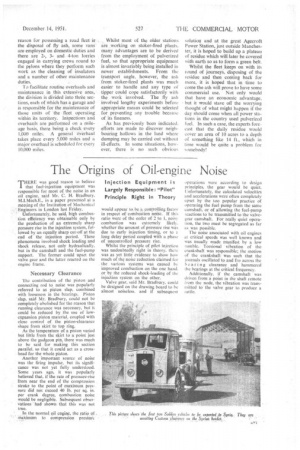Modern Power Stations Need Special Transport
Page 54

Page 57

If you've noticed an error in this article please click here to report it so we can fix it.
By Ashley Taylor, A.M.I.R.T.E.
The Use of Pulverized Fuel has Created Ashdisposal Problems which have been met by the Employment of Special Tippers SPECIALIZED refuse disposal is
, not a thing in these days which is • exclusively a municipal operator's preserve. Rather surprisingly, the British Electricity Authority does quite a lot of it, employing an extensive fleet for the purpose, for the modern power station often operates entirely on pulverized fuel and the i emoval of the ash is a major problem. Whilst all kinds of experiments are going on, up to the present no commercial use has been found for this residue. • • For the purpose of examining the subject, it is of interest to take the case of the B.E.A. , north-western division which covers an area of 4,830 sq. miles, lying between Carlisle and Buxton and including Cumberland Westmorland, East Cheshire. part of the West Riding of Yorkshire
and. part. of the Derbyshire Peak district. Generating stations are scattered throughout this area and plant nt: the pulverized-fuel type has already been widely adopted.
,Something like 15-20 per cent, of ash may be regarded As the usual residue resulting from the combustion proCess, and it is a matter of sonic concern to find suitable places for tipping to take place. Ash from stoker-fired 'plants is a different case, for in most instances it can . be employed for filling-in on constructional work and in the manufacture of such things as ash-concrete slabs.
Old mine shafts, disused excavation's and other hollows are suitable places for the disposal of the pulverized-coal ash and, according to circumstances the vehicles employed on such duties may be operating within any radius between half-amile and five mites of their potter station centre.
Altogether, some 160 vehicles; of a variety of makes are employed in the north-western division, capacities varying up to 5 tons. Suitable numbers of individual vehicles arc allocated to the various generating stations throughout the area, tippers of various types being employed. Good results have been achieved with the Jekta type of body which works on the telescopic principle.
To. prevent the load blowing away. and particularly to prevent its dispersal during the process of tipping, the light ash is 'sprayed with water, but this in turn brings fresh problems. When tipping takes place, the dammed ash tends to adhere to the,, body, , but ,.difficulties, omi. account have been overcome by the Jekta's powerful telescopic action, which effectively clears away the
load.
Although the Authority's chief reason for possessing a road fleet is the disposal of fly ash, some vans' are employed on domestic duties and there are 2-, 3and 4-ton lorries engaged in carrying crews round to the pflons where they perform such work as the cleaning of insulators and a number of other maintenance duties.
To facilitate routine overhauls and maintenance in this extensive area, the division is divided into three sections, each of which has a garage and is responsible or the. maintenance of those units of the fleet operating within its territory. Inspections and overhauls are performed on a mileage basis, there being a check every 1,000 miles. A general .L-1,verhaut takes place every 5,000 Miles and a major overhaul is scheduled for cVery 10,000 miles.
Whilst most of the older stations are working on stoker-fired plants, many advantages are to be derived from the employment of pulverized fuel, so that appropriate equipment is almost invariably being installed in newer establishments. From the transport angle, however, the ash from stoker-fired plants was much easier to handle and any type of tipper could cope satisfactorily wit h the. work involved. The fly ash involved lengthy experiments before appropriate means could be selected for preventing any trouble because of its fineness.
As has previously been indicated. efforts are made to discover neighbouring hollows in the land where dumping may be carried out without ill-effects. In some situations, however, there is no such obviotr-;
solution and at the great Agecroft Power Station, just outside Manchester, it is hoped to build up a plateau of residue which will later be covered with earth so as to form a green belt.
Whilst the fleet keeps on with its round of journeys, disposing of the residue and then coming back for more, it is hoped that in tit-pc to come the ash will prove to have some commercial use. Not only would that have an economic advantage, but it would stave off the worrying thought of what might happen if the day should come when all power stations in the cOuntry used pulverized fuel. In such a case, the experts forecast that the daily residue would cover an area of 10 acres to a depth of something like 14 ft., which in time would be quite a problem for. somebody!




























































































